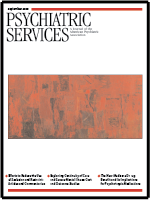The literature about barriers to public mental health treatment after a disaster remains sparse. In this letter we present data to address two questions: Are perceived barriers to mental health treatment different after a disaster than they are during less exigent times? And does the implementation of a public mental health program alter perceived barriers to mental health treatment after a disaster?
The findings are part of a larger study designed to assess the mental health consequences of the September 11, 2001, attacks (
1). A random sample of 832 residents of the New York City metropolitan area were interviewed approximately two years after the September 11, 2001, attacks. Respondents were read the following statement: "I'm going to read you some statements about people who needed help for problems with emotions or nerves or problems with their use of alcohol or drugs after the World Trade Center disaster. Then I will ask you to compare them to people who need professional help [during other times]." We then asked, "Would you agree or disagree that many people who needed professional help for problems with their emotions or nerves or problems with their use of alcohol or drugs after the World Trade Center disaster [did not know how to get help]?" After a response to this question was given, the question continued by asking if this barrier also affected mental health treatment in general.
The sequence continued in this way for five additional barriers: thought they could take care of the problem themselves, were too overwhelmed to get help, were worried about people thinking less of them for getting help (a stigma-related concern), did not have the money to pay for it, and were worried about taking the spot of somebody who needed help more than they did. We also asked if respondents were aware of Project Liberty, a statewide public mental health outreach program implemented after the September 11, 2001, terrorist attacks.
Two-tailed chi square tests were used to compare the responses about barriers before and after the September 11 attacks and to examine whether respondents who had knowledge of Project Liberty perceived fewer barriers to mental health treatment after the attacks than respondents with no knowledge of the program. A p value of .05 or less was considered significant.
Statistically significant differences were found for three of the six barriers. Respondents were more likely to agree that people were too overwhelmed to seek help after the attacks (616 respondents, or 74 percent) than during other non-disaster times (541 respondents, or 65 percent). Respondents were also more likely to agree that people were concerned about taking the spot of somebody who needed the services more after the attacks (391 respondents, or 47 percent) than during other non-disaster times (300 respondents, or 36 percent). By contrast, stigma-related concerns were believed to be less prevalent after the attacks (391 respondents, or 47 percent) than during other non-disaster times (466 respondents, or 56 percent).
Respondents who had heard of Project Liberty (474 respondents, or 57 percent) were less likely than those who had not to say that a lack of knowledge about how to get treatment was a problem in the post-disaster period (289 respondents, or 61 percent, compared with 247 respondents, or 69 percent). Respondents who had knowledge of Project Liberty were less likely than those who did not to say that stigma was a barrier after the September 11 attacks (209 respondents, or 44 percent, compared with 193 respondents, or 54 percent).
On the basis of a random sample of New York City residents who were interviewed two years after the September 11 attacks, perceived barriers to mental health treatment appear to be different after a disaster than during other times. Awareness of Project Liberty appears to have lessened concerns about stigma and cost. Future studies should examine barriers to mental health treatment among persons who used mental health services before and after a major disaster.

